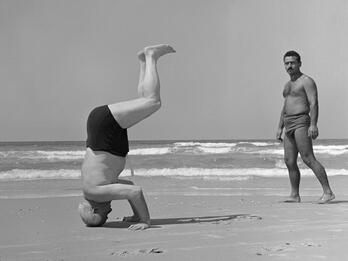Visual and Material Culture in the Mid-Twentieth Century
Jewish visual art flourished and diversified in the postwar period, reflecting the social and political transformations taking place in the world.
“Is there a Jewish art?” asked the noted art critic Harold Rosenberg in 1966, to which he replied: “What do you mean by Jewish art? ” In answering his own question with a question, Rosenberg makes the important point that, like other genres, Jewish art resists hard-and-fast definitions. Like A. Leyeles in his poem “The God of Israel,” in which he lists “A Chanukah-lamp, a curtain, a scroll, / A spice-box, tefillin, a pointing Hand, / A menorah, a Torah Crown, tools for circumcision,” Rosenberg threw out possible answers, including art produced by Jews, art with undeniably Jewish themes, and ceremonial objects. He also suggested that we pay attention to what he called “identity,” the striving of many Jewish artists—outsiders, with an “in-between” status in America—to break the mold and to affirm their individuality. “The work inspired by the will to identity,” Rosenberg noted, “has constituted a new art by Jews which . . . is a profound Jewish expression.”1
In the aftermath of the Holocaust, the establishment of a Jewish state, and the postwar transformation of American Jewry, Jewish artistic creativity took place in strikingly altered conditions. Some Jewish artists deliberately returned to Jewish themes as others embraced an abstract expressionism that challenged critics to discover or deny Jewish influences. More than other genres the visual arts were transnational: geographical boundaries more fluid. Marc Chagall’s White Crucifixion was painted in Paris, his stained-glass windows for the Hadassah Hospital chapel were done in Jerusalem, his illustrations for his wife’s memoir, Burning Lights, were produced in New York City. And even as New York displaced Paris as the center of the art world, many Jewish artists explored the creative tension between the abstract and the representative, between universal and Jewish themes.
The establishment of new Jewish museums and a postwar surge in the building of synagogues and community centers gave Jewish artists and architects new sources of material support and wider professional horizons. In Israel, Jewish artists looked for ways to create a new, distinctly “Israeli” art that could at the same time find recognition in the international art world. In the Soviet Union, where Jewish artistic expression was increasingly blocked, photography became an increasingly important medium.
In short, Jewish visual arts in this highly dramatic period of Jewish history, 1939–1973, presented a broad canvas, whose artists—men and, increasingly, women—run the gamut, from committed Jews engaged with explicitly Jewish themes to those, like the painter Ben Shahn, who bristled at being called Jewish artists. But it is precisely this variety and indeterminacy that define the Jewish visual arts of this time.
Notes
Harold Rosenberg, “Is There a Jewish Art?,” Commentary, July 1966, https://www.commentary.org/articles/harold-rosenberg-2/is-there-a-jewish-art/.


